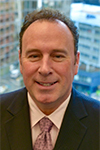HR Leadership at All Levels: From the Table to the Frontline
By Nancy Painter
It’s a common topic when HR professionals gather to discuss the state of the profession – the often elusive seat at the executive table. While familiar questions arise, their importance to the ongoing success of organizations continues to grow. Does HR have a seat at the table? If not, why not? What can HR leaders contribute there? Most importantly, how do they get there?
How Far Has HR Come?
The human resources profession has made great strides in recent years, expanding beyond what was once merely an operational function. However, just how far it has come is up for discussion.

Lewisa Anciano, CHRP
“I think it all depends on what organization you’re in and its attitude toward HR,” says Lewisa Anciano, CHRP, the VP of human resources at Coast Capital Savings and HRMA’s 2015 HR Professional of the Year. “HR’s role is a work in progress. We’ve made progress over the years, but there is still an opportunity to make a more fulsome contribution.”
While HR should be an integrative executive function, too often it’s only recognized for its operational contributions, according to Susan Kleinschmidt, founder of Victoria’s Good Insights Strategy. “There are often times when the executive team gets together and decides on strategy—and then comes to HR.”
Growing Into Business: Integrating HR
As a relatively new player in the business world, HR is evolving more rapidly than longer-established professions. The challenge is that not everyone has kept up with what HR now offers, nor do they recognize the potential benefits across organizations that can result from greater HR involvement at a strategic level.
Moreover, while others are having trouble seeing past HR’s original transactional nature, HR professionals themselves sometimes get mired in the everyday processes at the expense of taking a broader view.

Susan Kleinschmidt
“We often don’t have the time to step out and look at the higher level, at organizational strategy and moving the organization forward,” Kleinschmidt says. “We can get caught concentrating on process over progress, and we need to switch that. We need to focus on outcomes.”
HR must become integrated on two levels, according to Adam Cotterall, CHRP, a partner with The Caldwell Partners International and a visiting lecturer at the Beedie School of Business at Simon Fraser University.
The first level is within the HR function itself, relating all HR functions to each other for integrated talent management, working together toward common goals to create “human capital management solutions.”

Adam Cotterall, CHRP
Beyond that, Cotterall says, HR leaders must be enterprise-wide leaders, with the business acumen to understand the context within which their function sits.
While the responsibility for that lands squarely on HR professionals, there also has to be organizational readiness to listen and learn, he adds. “The executive team, the unions – they all have to be ready to look at new ways to do things and to be more effective.”
HR Integral to Evolving Economy
The benefits for the entire organization can be huge, beginning with HR’s already-differentiated area of expertise—people.
“The heart of any organization is its people,” Kleinschmidt points out. “HR has a global view across the organization. HR can look at the capability and capacity of the people and help the other leaders—because you accomplish nothing if you don’t bring your people along with you.”
As the larger economy has shifted from being production-based to information-based, HR’s potential impact has grown exponentially, says Kleinschmidt. “The workforce is now much more complicated than it once was, and the styles of leadership have changed,” she explains. “Command and control no longer works. While HR itself can’t change engagement, we can support the other leaders to establish the right culture and working environment that engage employees.
Building Bridges on the Front Line
“HR has a key role to play in keeping the link clear between the person on the front line and where the organization is going.” With an engaged workforce, Kleinschmidt adds, the overall organization becomes more responsive, flexible and productive.
This, she adds, is why it is key to have HR at the executive table so that people decisions aren’t afterthoughts, but key considerations in strategic decisions.
“We can be the key advocate for corporate culture and values, for the people in the organization. That’s a huge competitive advantage, and one that is really hard for other organizations to duplicate. The feeling, the atmosphere in an organization, can make it easier to recruit and retain good employees, causing overall costs to go down,” says Kleinschmidt. “HR is the group within an organization that can make that a reality.”
Going Far and Wide for Alignment
Cotterall describes a similar function within what he calls “better vertical and horizontal alignment” that results from a fully-integrated, executive HR role.
“Vertically, HR can cascade objectives through performance management or strategic planning, so people throughout the organization understand how their work links to corporate objectives,” Cotterall explains.“Horizontal alignment means fewer silos and better cross-organizational communication.”
Significantly, improved alignment results in a company that is more responsive to its external environment, its market, competitive changes, customer desires, regulators, stakeholders and other external elements—all factors in greater organizational effectiveness and productivity, he explains.
“If change happens externally, something internally has to change to respond. The pace of change is fast, and there’s lots of ambiguity and complexity. We must figure out appropriate and timely responses to address the changes,” says Cotterall.
Insofar as HR can create programs and encourage cultures which encourage employee feedback and customer/stakeholder interaction, HR is ideally equipped to deliver key information back to decision makers. This allow for better decisions around direction and resource allocation, Cotterall adds, “rolling quantitative and qualitative data into decision-making.”
Bringing Balance (and People) to Strategy
Anciano describes HR’s expertise as balancing people and business. “An organization can be too concentrated on either viewpoint,” she says.
HR can be the facilitator that brings the two together, but only if HR leaders have an “enterprise mentality,” Anciano adds. “We must be able to think in multiple ways, to see things from the enterprise, people and individual points of view. If we can connect the dots, we can proactively identify both possibilities, and the unintended consequences that could result from strategic decisions. We have to look at the people and the business, both short- and long-term.”
By enabling that risk management function, HR can help organizations prevent costly errors. “We can save people and the organization from themselves,” she explains.
Success for any organization begins with having the right people who are hungry to learn, according to Anciano, pointing out that it is estimated that 50 per cent of today’s jobs won’t exist in 10 years.
“The only way to survive is if people are hungry to learn and grow, to develop and continually improve. We need to give people the right incentives to learn and grow with the organizations. We can’t stand still. It’s change or die,” says Anciano.
While that type of environment requires companies and workforces to be more resilient and knowledgeable in adaptability skills and abilities, Anciano maintains that the opportunities it offers are what makes the HR role fun—and progressively grounded in leadership decisions.
Leadership Begins with Trusted Relations
Relationship is integral to such progress. The key step in gaining a seat at the executive table is to establish a trusted advisor relationship with leaders, Anciano says. “We need them to tell us how they make their decisions, so we can gently influence them on how to mitigate their strategies’ impact on people.”
Kleinschmidt says, “HR needs to understand what the leadership team needs, instead of telling them what HR thinks they need to do. We can walk beside them and hold up a picture of what success can look like. We want to be the go-to person, so if leaders are having difficulties, the first place they call is HR.”
Anciano describes that as building a brand based on credibility. “What do people say about you at the water cooler when you’re not there? We need to earn their respect so they ask us for advice.”
The key to that respect is to learn the business, she continues. “We need to understand how we make or lose money so we can help managers leverage people to enable greater revenue,” says Anciano.
With that type of understanding, HR is able to propose solutions to company-wide problems. “We’re good at shining a light on issues, but we need to provide end-to-end solutions,” she explains.
In addition, for HR to be recognized for its contributions, Anciano says, “we need to measure our impact, report it and be proud of the impact we have.”
First and Foremost? Bring the Business Forward
Being business people first and HR leaders second is crucial, according to Cotterall. “The strongest HR leaders are indiscernible from other leaders in a business meeting. When I held a café-style event with six business leaders for my MBA students, the students had no idea which one was the HR leader.”
“We need to start conversations at pricing, competition, the product road map, regulators—and then link to the talent implications. The leadership team members have to collectively think about business strategy, looking at the business first and their individual functional areas second,” says Cotterall.
It’s not unusual to see business experts from other areas of an organization appointed to head up the HR department, he notes. HR leaders can prevent that by bringing business expertise to their role and demonstrating an understanding of the larger picture in their organization.
Cotterall cites the example of the association of the former Certified Management Accountants (now rolled into the new Chartered Professional Accountant designation). CMA was built on three pillars: management, business or strategy, and accounting.
“We will have so much power if we as an association move towards that three-pillar approach,” shares Cotterall. “It could be leadership or management, business or strategy, and HR. But right now those other two pillars are short compared to the HR one. They need to be balanced.”
Making People Key to C-Suite Strategy
That balance is in the making.

Rock Lefebvre
“We have an exciting opportunity to become more integrated into C-suite planning,” says Rock Lefebvre, HRMA’s chief regulatory officer. “We have the talent and the skill to maximize the people power in organizations, to empower them and unleash their talent.”
“People are often under-employed in organizations that are hungry for talent. HR people can change that, by enabling skill sets to become more fully utilized, by allowing the free movement of talent and motivating employees,” says Lefebvre. “HR is best positioned to find out how to tap that potential for organizations.”
Trained HR professionals understand both organizational behaviour and interpersonal relationships Lefebvre says, “and any organization is an aggregate of human beings. Individuals who have a clear development path contribute to the organization. When we increase the emphasis on the human contribution, they’re self-actualized and they advance. The organization is in harmony.”
“We have been trained to do things right,” he explains. “Now it’s time to do the right things. That can be very powerful.” A more holistic approach results in a high-achieving organization that taps into its workforce’s potential.
Self-regulation Communicates and Safeguards
However, HR leadership hopefuls can have all the expertise in the world but face barriers moving forward unless someone recognizes their assets.
The solution to that, Lefebvre says, is to build wide awareness of what HR can do through a self-regulated professional organization and designation. “The same way that organizations rely on the chief financial officer, they will come to rely on their chief HR officer.”
There is strong support for self-regulation within Canada’s HR profession. Ontario and Quebec have already achieved it. In British Columbia and other provinces, the profession is reaching out to legislators to get the issue on the order paper.
“We will continue to become more organized by becoming self-regulated, setting high standards for entry and professional development to protect both the public and members,” explains Lefebvre.
“Every organization will have a benchmark against which to measure themselves,” he continues. “As a profession that is self-regulated, we will increasingly raise the bar and demand more of our members, which means employers will get more. We can measure our performance, enabling us to improve over time.”
National self-regulation will also ensure that designated human resources professionals adhere to substantially equivalent standards of care and conduct, that credentials are mobile and transferable, and that designations are publicly recognized and understood. The CHRP is already in the process of being introduced in Hong Kong and other parts of the world as well.
While some may see the designation as only letters, there is no denying that it can open doors for HR professionals. A disciplined, regulated designation ensures that employers can count on its holders to bring specific skills at an executive level. In effect, it is shorthand for high entrance standards, education, compliance and continuing education.
The public that CHRPs pledge to protect naturally includes employees. CHRP holders have to be ambassadors to ensure that employment and labour legislation, regulations, standards and codes mean something in the workplace. HR professionals can oversee compliance and establish accountabilities within an organization.
Moreover, by consigning these important ‘people’ matters to trusted HR advisors who are governed by a professional code of ethics, HR can mitigate mediation and litigation costs within organizations that sometimes result from not following standards.
Setting Standards for HR Leadership
HRMA is introducing a new code of ethics, available now on the association’s website, as well as rules of professional conduct that members must follow to retain their CHRP designation.
The longstanding continuing professional development standard is being streamlined and modified to ensure it contributes the most it can to the profession. In future, members will have access through their professional organization to courses offered at Ivy League schools like Berkeley and Harvard universities.
Mandatory compliance standards are also under development. “We can never ensure that all CHRPs are infallible, but these steps will minimize errors and risk,” Lefebvre says, “and ensure that we have the best possible group of professionals within HR.”
“The designation has to resonate, to mean something to people. That will only happen if they see CHRPs in action, see the influence, the ownership and the staff empowerment and understand the success CHRPS can bring to their organizations,” Lefebvre says. “It will make all HR people better leaders.”
Changing Roles and Aligning Goals
While present, according to Cotterall, the presence of HR leadership will become more evident as HR departments move towards more automated self-service for employees, outsourcing of transactional functions, and rolling some HR practices into the duties and expectations of line managers.
“There’s more recognition by CEOs of this role, and it’s reflected in the structure, with HR reporting directly to the CEO instead of being one level removed,” he says. Just as manufacturers refer to their direct suppliers as tier-one suppliers, HR is becoming a tier-one player on the executive team.
“Business is moving toward fewer people in HR, so that eventually they won’t need HR for transactional and functional aspects, but they will still need HR on a strategic level,” says Cotterall. “We are the stewards of culture. In fact, you often hear the job title as VP of people and culture now instead of VP of HR.”
“HR needs to be humble ,but be hungry,” Anciano says. “We need to be continuously learning, taking feedback, growing—being uncomfortable. In the future, I see innovative and dynamic HR people, not doing HR in the traditional way. We need to be edgy, dynamic innovators and disruptors. If business is going to be disrupted, why not HR? We have the will and courage to do all that. If we don’t, we might be some of those people whose jobs don’t exist in ten years!”
In short, as Lefebvre concludes, “The power and magnitude of HR professionals’ contribution is immense. Who could be more powerful than the person who empowers people?”
Nancy Painter is a freelance business writer and a member of the International Association of Business Communicators.
(PeopleTalk Winter 2015)









